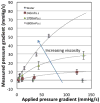The effect of luminal content and rate of occlusion on the interpretation of colonic manometry
- PMID: 23228077
- PMCID: PMC3539177
- DOI: 10.1111/nmo.12051
The effect of luminal content and rate of occlusion on the interpretation of colonic manometry
Abstract
Background: Manometry is commonly used for diagnosis of esophageal and anorectal motility disorders. In the colon, manometry is a useful tool, but clinical application remains uncertain. This uncertainty is partly based on the belief that manometry cannot reliably detect non-occluding colonic contractions and, therefore, cannot identify reliable markers of dysmotility. This study tests the ability of manometry to record pressure signals in response to non-lumen-occluding changes in diameter, at different rates of wall movement and with content of different viscosities.
Methods: A numerical model was built to investigate pressure changes caused by localized, non-lumen-occluding reductions in diameter, similar to those caused by contraction of the gut wall. A mechanical model, consisting of a sealed pressure vessel which could produce localized reductions in luminal diameter, was used to validate the model using luminal segments formed from; (i) natural latex; and (ii) sections of rabbit proximal colon. Fluids with viscosities ranging from 1 to 6800 mPa s(-1) and luminal contraction rates over the range 5-20 mmHg s(-1) were studied.
Key results: Manometry recorded non-occluding reductions in diameter, provided that they occurred with sufficiently viscous content. The measured signal was linearly dependent on the rate of reduction in luminal diameter and also increased with increasing viscosity of content (R(2) = 0.62 and 0.96 for 880 and 1760 mPa s(-1), respectively).
Conclusions & inferences: Manometry reliably registers non-occluding contractions in the presence of viscous content, and is therefore a viable tool for measuring colonic motility. Interpretation of colonic manometric data, and definitions based on manometric results, must consider the viscosity of luminal content.
© 2012 Blackwell Publishing Ltd.
Conflict of interest statement
Competing Interests: the authors have no competing interests.
Figures








Similar articles
-
Discriminating movements of liquid and gas in the rabbit colon with impedance manometry.Neurogastroenterol Motil. 2018 May;30(5):e13263. doi: 10.1111/nmo.13263. Epub 2017 Dec 13. Neurogastroenterol Motil. 2018. PMID: 29235207
-
Temporal relationships between wall motion, intraluminal pressure, and flow in the isolated rabbit small intestine.Am J Physiol Gastrointest Liver Physiol. 2011 Apr;300(4):G577-85. doi: 10.1152/ajpgi.00532.2010. Epub 2010 Dec 30. Am J Physiol Gastrointest Liver Physiol. 2011. PMID: 21193528
-
The effect of colonic tissue electrical stimulation and celiac branch of the abdominal vagus nerve neuromodulation on colonic motility in anesthetized pigs.Neurogastroenterol Motil. 2020 Nov;32(11):e13925. doi: 10.1111/nmo.13925. Epub 2020 Jun 23. Neurogastroenterol Motil. 2020. PMID: 32578346 Free PMC article.
-
High resolution colonic manometry--what have we learnt?--A review of the literature 2012.Curr Gastroenterol Rep. 2013 Jun;15(6):328. doi: 10.1007/s11894-013-0328-2. Curr Gastroenterol Rep. 2013. PMID: 23709203 Review.
-
Manometric techniques for the evaluation of colonic motor activity: current status.Neurogastroenterol Motil. 2003 Oct;15(5):483-513. doi: 10.1046/j.1365-2982.2003.00434.x. Neurogastroenterol Motil. 2003. PMID: 14507350 Review.
Cited by
-
Use of In Vitro Dynamic Colon Model (DCM) to Inform a Physiologically Based Biopharmaceutic Model (PBBM) to Predict the In Vivo Performance of a Modified-Release Formulation of Theophylline.Pharmaceutics. 2023 Mar 9;15(3):882. doi: 10.3390/pharmaceutics15030882. Pharmaceutics. 2023. PMID: 36986743 Free PMC article.
-
Interstitial cells of Cajal: update on basic and clinical science.Curr Gastroenterol Rep. 2014 Jan;16(1):363. doi: 10.1007/s11894-013-0363-z. Curr Gastroenterol Rep. 2014. PMID: 24408748 Review.
-
Inference of mechanical states of intestinal motor activity using hidden Markov models.BMC Physiol. 2013 Dec 11;13:14. doi: 10.1186/1472-6793-13-14. BMC Physiol. 2013. PMID: 24330642 Free PMC article.
-
Manometry of the Human Ileum and Ileocaecal Junction in Health, Disease and Surgery: A Systematic Review.Front Surg. 2020 Apr 15;7:18. doi: 10.3389/fsurg.2020.00018. eCollection 2020. Front Surg. 2020. PMID: 32351970 Free PMC article.
-
The Effect of Biorelevant Hydrodynamic Conditions on Drug Dissolution from Extended-Release Tablets in the Dynamic Colon Model.Pharmaceutics. 2022 Oct 14;14(10):2193. doi: 10.3390/pharmaceutics14102193. Pharmaceutics. 2022. PMID: 36297627 Free PMC article.
References
-
- Jones MP, Post J, Crowell MD. High-resolution manometry in the evaluation of anorectal disorders: a simultaneous comparison with water-perfused manometry. Am J Gastroenterol. 2007;102:850–855. - PubMed
-
- Pandolfino JE, Ghosh SK, Rice J, Clarke JO, Kwiatek MA, Kahrilas PJ. Classifying esophageal motility by pressure topography characteristics: a study of 400 patients and 75 controls. The American Journal of Gastroenterology. 2008;103:27–37. - PubMed
-
- Smout AJPM. Recent developments in gastrointestinal motility. Scand J Gastroenterol Suppl. 2006;41:25–31. - PubMed
-
- Sarna SK. Colonic Motility: From Bench Side to Bedside. 2011/04/01. Morgan & Claypool Life Sciences; 2010. - PubMed
-
- von der Ohe MR, Hanson RB, Camilleri M. Comparison of simultaneous recordings of human colonic contractions by manometry and a barostat. Neurogastroenterol Mot. 1994;6:213–222.
Publication types
MeSH terms
Grants and funding
LinkOut - more resources
Full Text Sources

